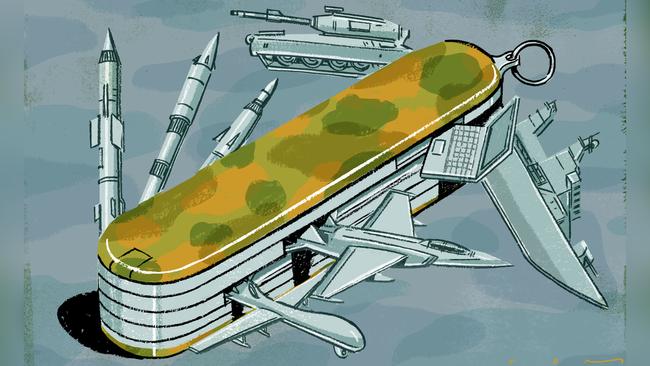Defence needs smaller, cheaper, more agile weapons

The recent call for a defence reset by two former air force chiefs adds to the growing pressure on Defence Minister Linda Reynolds to review the strategy of the 2016 defence white paper and the structure and geographical focus of the Australian Defence Force.
Retired air marshal Leo Davies and his immediate predecessor, Geoff Brown, say our defence strategy is outdated and that the ADF is poorly equipped to deal with emerging threats to our maritime trade, China’s rapid military modernisation and the possibility of great power conflict in the region.
More controversially, Davies asserts that an ADF constituted for nation building in the Middle East cannot defend our vital “sea lines of communication” in the Pacific and that the emphasis on land forces has gone too far, creating a major gap in Australia’s defence capability. This criticism is echoed by Brown who says the air force, not the army, should now be the service of “first resort”.
Having well-credentialed former air force chiefs engage in an important national debate is rare but welcome. However, Reynolds would be wise to take her own counsel before accepting some of their more questionable advice.
Australia undoubtedly faces a different and more volatile strategic environment than envisaged a decade ago. The most destabilising changes are the faster-than-expected capacity and willingness of China to project power into the Pacific, and the proliferation of new military technologies amid concerns about a possible US retreat from the region and alliance commitments. A re-examination of defence strategy and capabilities is warranted.
The most pressing capability gap is the ADF’s inability to deliver long-distance firepower, or “strike” power in defence parlance. Our 72 Joint Strike Fighters will carry only a small number of bombs and medium-range missiles and have limited flying range without stealth-reducing in-flight refuelling. Moreover, the first of the much-touted submarines may not be fully operational until 2035. Protecting against sophisticated, state-based cyber attacks is also a problem and we have no real defence against the latest generation of long-range, super-fast hypersonic missiles that Russia and China are about to deploy, or their ballistic missile cousins.
Davies and Brown are right to be concerned about the ADF’s lack of strike power and protection against emerging threats. But developing new offensive and defensive capabilities does not mean prioritising air force needs over those of the rest of the ADF and certainly not at the expense of the land force, which has a vital role to play in our evolving strategy.
This smacks of special pleading and flies in the face of longstanding attempts to integrate the capabilities and culture of the three services to reduce interservice rivalries and budget squabbling. A great deal of money has been poured into bolstering our air and maritime capabilities across two decades to the point where we have what many believe is the best small air force in the world. Navy is being rebuilt to a similar standard. Reinvesting in the land force is essential if we are to maintain a balanced force structure that allows the ADF to meet all its commitments and not be dangerously overweight in one. Defence analyst John Coyne is justifiably concerned that “the idea of scaling up and down from a balanced force seems to have been lost”.
There are better ways to enhance the strike power of the ADF than acquiring expensive manned bombers such as the B-21 from the US at more than $800m each. We need to move away from big, expensive, drawn-out equipment purchases to cheaper, quicker defence solutions. It’s time to get serious about using unmanned strike aircraft in tandem with smaller, dispensable drones, land-based, long-range precision guided munitions and ballistic missiles all of which can be turbocharged by artificial intelligence.
Giving higher priority to great power conflicts doesn’t mean restructuring our defence force to take on a great power or policing vast stretches of the Pacific. This would be prohibitively expensive and militarily self-defeating for a country of 25 million.
The US alliance remains the most cost-effective deterrent against military coercion or attack from a hostile major power, which is why we should continue to invest political capital in ensuring the US remains fully engaged in the region rather than needlessly worrying about a US retreat. The Indo-Pacific engages just about every core US interest and even an alliance-sceptical, transactional president such as Donald Trump understands that Australia is a valuable ally that pays its dues. The idea that the ADF has been primarily engaged in nation-building in the Middle East, implying that it should now be put on B-21 steroids for high-end warfare in the Pacific, also needs rebutting.
Of our three deployments to Iraq since 2003 the first was to help disarm the regime of Saddam Hussein, the second was for training and reconstruction. The third was a counterterrorist operation against Islamic State that involved a training team and an air task group operating from the United Arab Emirates that flew multiple combat missions in Iraq. The initial ADF deployment to Afghanistan, which is not in the Middle East, was a direct response to the 9/11 terrorist attack on the US by al-Qa’ida, although it later turned into a counter-insurgency operation that included some nation-building activities.
The point is the ADF was sufficiently flexible and multiskilled to carry out a wide range of operations in the Middle East, Afghanistan and Indian Ocean to counter insurgents, terrorists, pirates, narcotics-traffickers and sanction-busters. Even with a renewed emphasis on conventional warfighting there still will be a requirement to do all these tasks in support of our wider interests, alliance obligations and the liberal democratic order. Proximity should not be the only determinant of where we deploy. The ADF needs more land and maritime-strike assets as well as greater protection against missile and cyber threats to recalibrate for the challenges ahead. But the choices made must be appropriate, affordable and not be at the expense of other necessary capabilities.
Alan Dupont is chief executive of geopolitical risk consultancy the Cognoscenti Group and a non-resident fellow at the Lowy Institute.


